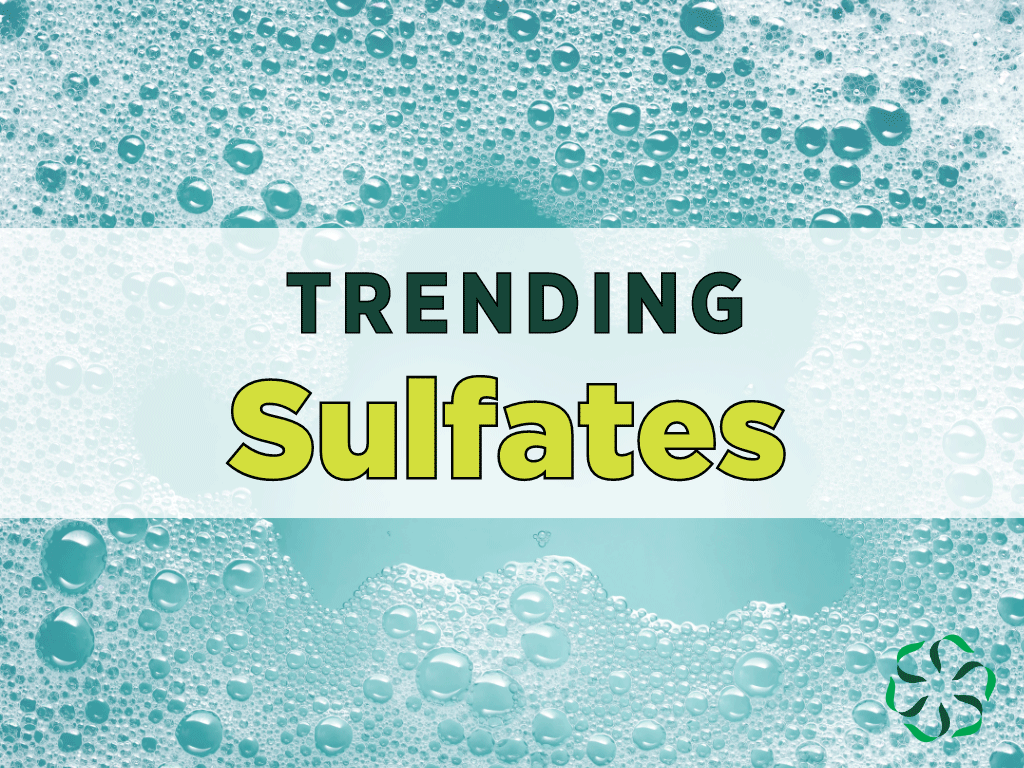We’ve seen personal care and cosmetic products move away from sulfate ingredients. In this post, we explore sulfate ingredients in cosmetics and food and their safety.
What are sulfates?
Sulfates describe ingredients with water soluble and water insoluble properties, allowing them to act as surfactants (1).
A surfactant is a compound that reduces surface tensions between two substances, allowing two substances that would typically repel to mix. For example, oil and water do not mix, but if we introduce a surfactant agent, the surfactant can dissolve the oil, allowing the oil and water to combine. We see this chemical reaction in dish soap.
We also see a common sulfate ingredient used occasionally as a food additive in very small amounts to help emulsify egg whites and in other food processing techniques.
Where do I find sulfates? What are common sulfate ingredients?
We find sulfates in many soaps, detergents, cosmetics, and occasionally foods (1,2).
More than 60 sulfate ingredients are used in cosmetic and personal care products. The two most common sulfates are sodium lauryl sulfate (SLS) and sodium laureth sulfate.
One common sulfate ingredient is approved as a food additive in specific amounts: sodium lauryl sulfate (SLS).
For a complete list of the 60+ sulfate ingredients used in cosmetic and personal care products and their safety profiles, search for “sulfate” in the Cosmetic Ingredients Review database.
Are sulfates all-natural, or are they synthetically derived?
Like many ingredients, we can find sulfates in nature, or scientists and manufacturers can create sulfate ingredients.
In nature, we find them frequently in mineral salts in the environment.
For food, cosmetic, and personal care products in our everyday lives, manufacturers typically use chemical processes that use petroleum, plant, or animal sources to create common sulfate ingredients like sodium lauryl sulfate.
Are sulfates harmful to my health?
Unless you have sensitive skin or other health concerns, common sulfate ingredients do not harm humans when used as directed in cosmetic or personal care products.
Some people have raised concerns about the potential for common sulfate ingredients to cause eye damage, alopecia, and organ damage; others suggested that they may be carcinogenic. However, the peer-reviewed literature does not support those claims when using a cosmetic or personal care product containing a common sulfate ingredient as directed and relevant to human exposure.
In foods, sodium lauryl sulfate is safe to consume if it is within the guidelines established by the U.S. Food and Drug Administration.
What do I need to know about sulfate ingredients in cosmetic and personal care products?
While sulfate ingredients in shampoos do not harm people’s health, some do not like how their hair reacts to sulfate-containing haircare products. As a result, more manufacturers have moved to sulfate-free haircare product formulations and advertise using a marketing label that a product is sulfate-free.
A sulfate-free label does not suggest health. Again, it’s for marketing and informational purposes.
The good news.
Common sulfate ingredients are safe and effective cleaning agents that enable our personal hygiene so we can maintain our health.
If you have any questions about foods and ingredients, please email us or submit your idea at go.msu.edu/cris-idea.

